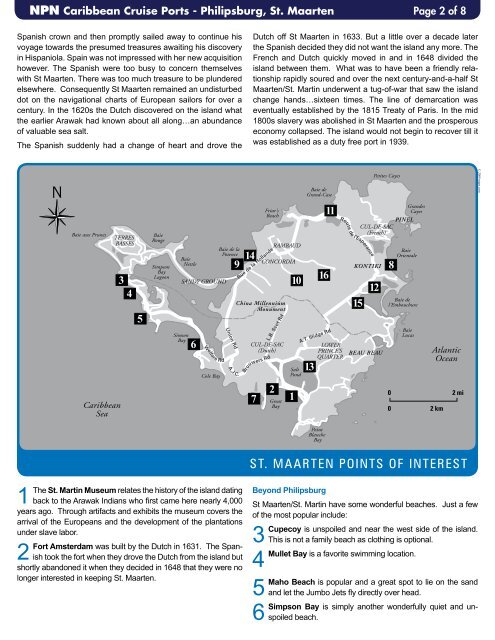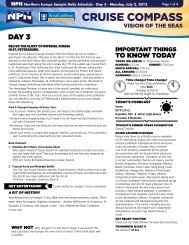Philipsburg, St. Maarten - NPN Cruise
Philipsburg, St. Maarten - NPN Cruise
Philipsburg, St. Maarten - NPN Cruise
You also want an ePaper? Increase the reach of your titles
YUMPU automatically turns print PDFs into web optimized ePapers that Google loves.
<strong>NPN</strong> Caribbean <strong>Cruise</strong> Ports - <strong>Philipsburg</strong>, <strong>St</strong>. <strong>Maarten</strong> Page 2 of 8<br />
Spanish crown and then promptly sailed away to continue his<br />
voyage towards the presumed treasures awaiting his discovery<br />
in Hispaniola. Spain was not impressed with her new acquisition<br />
however. The Spanish were too busy to concern themselves<br />
with <strong>St</strong> <strong>Maarten</strong>. There was too much treasure to be plundered<br />
elsewhere. Consequently <strong>St</strong> <strong>Maarten</strong> remained an undisturbed<br />
dot on the navigational charts of European sailors for over a<br />
century. In the 1620s the Dutch discovered on the island what<br />
the earlier Arawak had known about all along…an abundance<br />
of valuable sea salt.<br />
The Spanish suddenly had a change of heart and drove the<br />
1<br />
The <strong>St</strong>. Martin Museum relates the history of the island dating<br />
back to the Arawak Indians who first came here nearly 4,000<br />
years ago. Through artifacts and exhibits the museum covers the<br />
arrival of the Europeans and the development of the plantations<br />
under slave labor.<br />
2<br />
3<br />
4<br />
Fort Amsterdam was built by the Dutch in 1631. The Spanish<br />
took the fort when they drove the Dutch from the island but<br />
shortly abandoned it when they decided in 1648 that they were no<br />
longer interested in keeping <strong>St</strong>. <strong>Maarten</strong>.<br />
5<br />
6<br />
9<br />
14<br />
Dutch off <strong>St</strong> <strong>Maarten</strong> in 1633. But a little over a decade later<br />
the Spanish decided they did not want the island any more. The<br />
French and Dutch quickly moved in and in 1648 divided the<br />
island between them. What was to have been a friendly relationship<br />
rapidly soured and over the next century-and-a-half <strong>St</strong><br />
<strong>Maarten</strong>/<strong>St</strong>. Martin underwent a tug-of-war that saw the island<br />
change hands…sixteen times. The line of demarcation was<br />
eventually established by the 1815 Treaty of Paris. In the mid<br />
1800s slavery was abolished in <strong>St</strong> <strong>Maarten</strong> and the prosperous<br />
economy collapsed. The island would not begin to recover till it<br />
was established as a duty free port in 1939.<br />
7<br />
Beyond <strong>Philipsburg</strong><br />
<strong>St</strong> <strong>Maarten</strong>/<strong>St</strong>. Martin have some wonderful beaches. Just a few<br />
of the most popular include:<br />
3<br />
4<br />
5<br />
6<br />
2<br />
10<br />
1<br />
13<br />
16<br />
11<br />
15<br />
S T. M A A R T E N P O I N T S O F I N T E R E S T<br />
12<br />
Cupecoy is unspoiled and near the west side of the island.<br />
This is not a family beach as clothing is optional.<br />
Mullet Bay is a favorite swimming location.<br />
Maho Beach is popular and a great spot to lie on the sand<br />
and let the Jumbo Jets fly directly over head.<br />
Simpson Bay is simply another wonderfully quiet and unspoiled<br />
beach.<br />
8<br />
© 2009 maps.com



